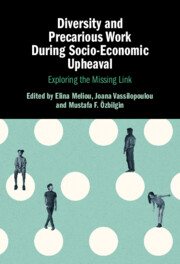Book contents
- Diversity and Precarious Work during Socio-economic Upheaval
- Diversity and Precarious Work during Socio-economic Upheaval
- Copyright page
- Contents
- Figures
- Contributors
- 1 Introduction
- 2 Pandemic Precarities and Gendered Biopolitics within the Neoliberal University
- 3 LGBTQ+ Individuals and Precarious Work
- 4 Age, Gender, and Precarity
- 5 How the (In)Ability of Using One’s Disability Strategically Reinforces Inequality and Precariousness amongst Disabled Workers
- 6 Classed and Gendered Experiences of Precarity in Dirty Work
- 7 Precarity and Diversity
- 8 Precarious Work in the Gig Economy
- 9 Refugees’ Vulnerability towards Precarious Work
- 10 Trapped in Precarious Work
- 11 How Precarity Is Threaded into Migration Rules
- 12 Culture, Precarity, and Dignity
- 13 Transforming Humanitarianism
- 14 Artificial Intelligence, the Gig Economy, and Precarity
- Index
- References
4 - Age, Gender, and Precarity
The Experience of Late Career Self-Employment
Published online by Cambridge University Press: 01 February 2024
- Diversity and Precarious Work during Socio-economic Upheaval
- Diversity and Precarious Work during Socio-economic Upheaval
- Copyright page
- Contents
- Figures
- Contributors
- 1 Introduction
- 2 Pandemic Precarities and Gendered Biopolitics within the Neoliberal University
- 3 LGBTQ+ Individuals and Precarious Work
- 4 Age, Gender, and Precarity
- 5 How the (In)Ability of Using One’s Disability Strategically Reinforces Inequality and Precariousness amongst Disabled Workers
- 6 Classed and Gendered Experiences of Precarity in Dirty Work
- 7 Precarity and Diversity
- 8 Precarious Work in the Gig Economy
- 9 Refugees’ Vulnerability towards Precarious Work
- 10 Trapped in Precarious Work
- 11 How Precarity Is Threaded into Migration Rules
- 12 Culture, Precarity, and Dignity
- 13 Transforming Humanitarianism
- 14 Artificial Intelligence, the Gig Economy, and Precarity
- Index
- References
Summary
The chapter explores the experience of late career self-employment. We adopt an intersectional perspective to theorise the precarity experienced by older self-employed women and provide insights into the societal and organizational structures and norms that shape ageing in employment and everyday life. We illustrate our arguments through three biographical cases of older self-employed women in the United Kingdom. Finally, we discuss the implications of age, gender, and self-employment and conclude with a call for inclusive policy to tackle precarity in self-employment.
Keywords
- Type
- Chapter
- Information
- Diversity and Precarious Work During Socio-Economic UpheavalExploring the Missing Link, pp. 58 - 78Publisher: Cambridge University PressPrint publication year: 2024



